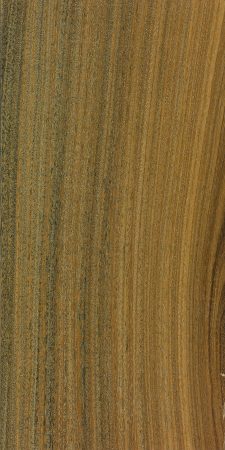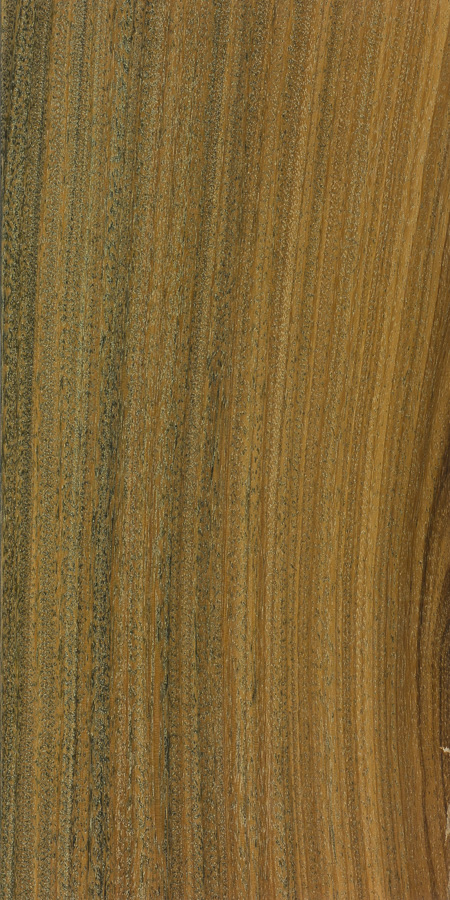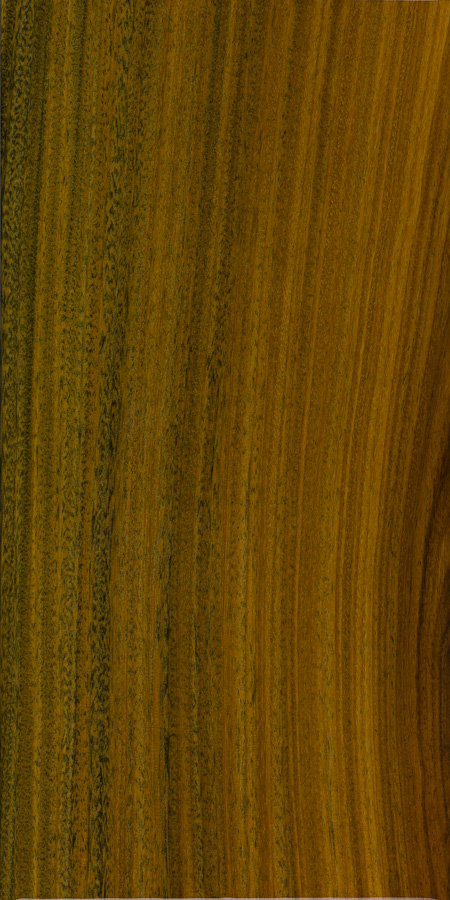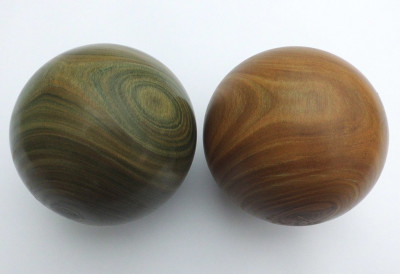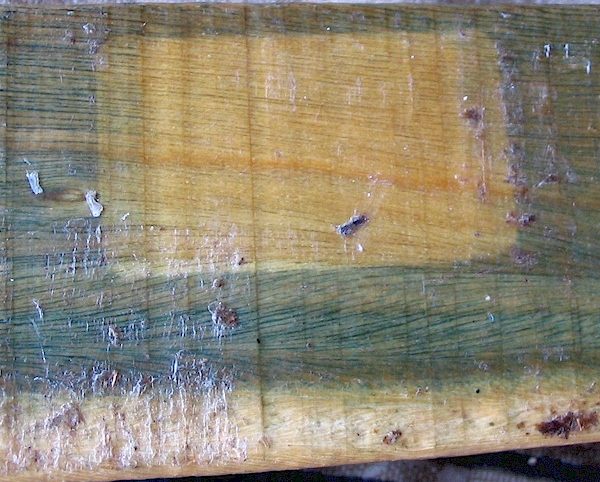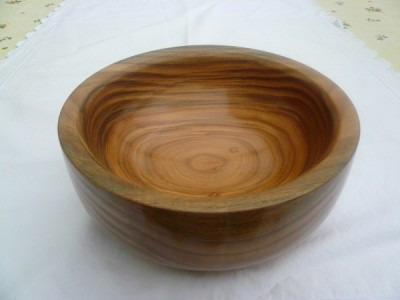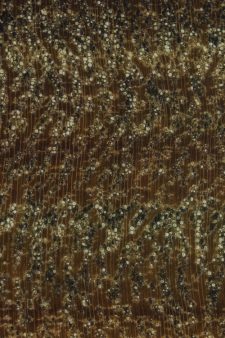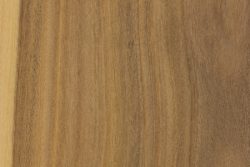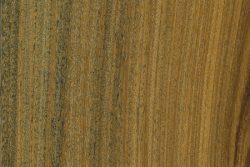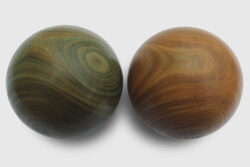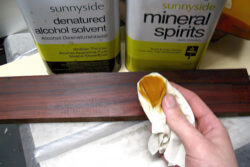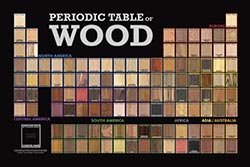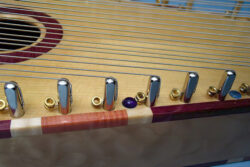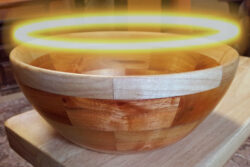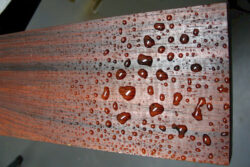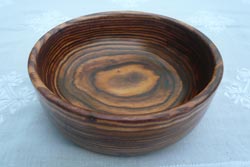Common Name(s): Argentine lignum vitae, palo santo
Scientific Name: Plectrocarpa sarmientoi (formerly placed in the Bulnesia genus; see comments below)
Distribution: Gran Chaco region of South America (much commercial lumber comes from Argentina)
Tree Size: 40-50 ft (12-15 m) tall,
1-2 ft (.3-.6 m) trunk diameter
Average Dried Weight: 74.9 lbs/ft3 (1,200 kg/m3)
Specific Gravity (Basic, 12% MC): 1.10, 1.20
Janka Hardness: 3,870 lbf (17,230 N)
Modulus of Rupture: 20,160 lbf/in2 (139.0 MPa)
Elastic Modulus: 2,618,000 lbf/in2 (18.05 GPa)
Crushing Strength: 13,800 lbf/in2 (95.2 MPa)
Shrinkage: Radial: 4.8%, Tangential: 7.8%,
Volumetric: 12.0%, T/R Ratio: 1.6
Color/Appearance: Heartwood color can range from pale yellowish olive to a deeper forest green or dark brown. The color tends to darken with age, especially upon exposure to light (see light-change color photo below). Pale yellow sapwood is clearly demarcated from heartwood. Quartersawn grain has a unique feathered or herringbone pattern when viewed up close.
Grain/Texture: Grain is usually interlocked. Fine even texture with very high natural luster.
Rot Resistance: Reported to be very durable for outdoor use—the related Plectrocarpa arborea is said to last “indefinitely.”[1]Chudnoff, M. (1984). Tropical timbers of the world (p. 56). US Department of Agriculture, Forest Service.
Workability: Argentine lignum vitae has a tendency to skip over-top jointer cutters on account of its extremely high density, and very light passes are recommended. It will also dull cutters, and overall it’s considered quite difficult to work. Also, due to its high oil content and hardness, it is very difficult to get a strong and reliable glue joint and can cause problems during finishing. However, verawood is an exceptional wood for turning on the lathe, and takes on an excellent natural luster.
Odor: Argentine lignum vitae has a distinct, perfume-like fragrance that lingers even after it has been machined. This species is currently protected as an endangered species—in part due to its over-harvesting for extraction of its fragrant oil, sometimes called oil of guaiac.
Allergies/Toxicity: While there are currently no reports on this exact species, sawdust from the closely related Plectrocarpa arborea has been reported to cause sneezing, and lignum vitae (also in the Zygophyllaceae family) has been reported to cause skin irritation. See the articles Wood Allergies and Toxicity and Wood Dust Safety for more information.
Pricing/Availability: Should be priced in the mid to upper range of imported exotic woods, with increasing scarcity. Turning blanks and other small pieces are sometimes available, comparing similarly with other premium tropical hardwoods. Larger pieces of craft lumber are less common but are also occasionally available.
Sustainability: This wood species is in CITES Appendix II, and is on the IUCN Red List. It is listed as endangered due to a projected population reduction of over 50% in the next three generations—primarily concentrated on the projected habitat loss in the Gran Chaco region of South America.[2]Barstow, M. 2018. Bulnesia sarmientoi. The IUCN Red List of Threatened Species 2018: e.T32028A68085692. https://dx.doi.org/10.2305/IUCN.UK.2018-2.RLTS.T32028A68085692.en. Accessed on 11 April … Continue reading
Common Uses: Tool handles, mallet heads, bearings, bushings, boatbuilding, pulley wheels, heavy construction (in areas where the tree grows locally), and turned objects.
Comments: True to its name, Argentine lignum vitae has very similar appearances and working characteristics to true lignum vitae (Guaiacum spp.). Though this Argentine species is in a different genus than lignum vitae, (Plectrocarpa and Guaiacum, respectively) both genera are biologically classified in the same family: Zygophyllaceae. Both woods are extremely hard, heavy, oily, and have a distinct brownish olive color. However, some retailers have adopted the dubious practice of dropping the “Argentine” or any other classifier from the common name and simply refer to Plectrocarpa species as lignum vitae. While Plectrocarpa is a satisfactory drop-in replacement for true lignum vitae for most applications (with the exception of bearings[3]Timbers of the World (p. 233). (1979). United Kingdom: Construction Press. TRADA.), this is a misleading omission that implies a historical wood of greater commercial value.
Recent genetic tests have shown that the two commercial species formerly placed in the Bulnesia genus belong in a separate genera. The initial report proposed these species be placed in Gonopterodendron—in the case of Argentine lignum vitae, Gonopterodendron sarmientoi,[4]Godoy-Bürki, A. C., Acosta, J. M., & Aagesen, L. (2018). Phylogenetic relationships within the New World subfamily Larreoideae (Zygophyllaceae) confirm polyphyly of the disjunct genus … Continue reading though subsequent classifications have placed these species in the genus Plectrocarpa.[5]Govaerts, R., Nic Lughadha, E., Black, N., Turner, R., & Paton, A. (2021). The World Checklist of Vascular Plants, a continuously updated resource for exploring global plant … Continue reading
Since genuine lignum vitae was in the inaugural round of CITES-listed endangered species from 1975, Argentine lignum vitae has been a popular substitute. Yet even this species has eventually found its way on to the same CITES Appendix II, with both species now being considered endangered.
Sometimes called palo santo (Spanish for ‘holy wood’) this wood is used for incense—though this common name is more commonly used for the species Bursera graveolens.
Images: Drag the slider up/down to toggle between raw and finished wood. The image showing the differences in color with light exposure was taken of a wax-covered turning blank (where the moisture/air exposure would’ve been more or less the same), yet the lighter portion was under a label—presumably showing that the difference was due to light exposure.
A special thanks to Steve Earis for providing turned photo of this wood species. (The two balls in the picture below were turned at different times and show the color change between fresh and aged wood.) You can see more of his work at Steve’s Wooden Skittle Pins and Balls.
Identification: See the article on Hardwood Anatomy for definitions of endgrain features.
Porosity: diffuse porous; growth rings sometimes subtly discernible due to decrease in pore frequency and size in latewood
Arrangement: predominantly radial multiples, pore chains, and sometimes clusters; in diagonal/radial arrangement (and sometimes dendritic)
Vessels: small to medium, moderately numerous to numerous
Parenchyma: diffuse-in-aggregates and vasicentric, though in practice parenchyma not really visible, even under 10x magnification
Rays: narrow width, normal spacing; rays not visible without magnification
Lookalikes/Substitutes: On account of its greenish color and high density, greenheart is one of the most commonly confused hardwoods with verawood. Other dense, olive-hued hardwoods (usually used for decking) can bear a similarity to verawood, such as ipe, cumaru, jucaro, and angelim vermelho—though all these woods lack the radial multiples and pore chains found in the unique anatomy of verawood.
Notes: The related species of true lignum vitae (Guaiacum spp.) in the Zygophyllaceae family bear the closest resemblance to verawood—though these species can also be separated from Plectrocarpa from their lack of radial multiples and pore chains. For more information on sorting these related species out, see the article How to Tell Genuine Lignum Vitae from Argentine Lignum Vitae.
Related Content:
References[+]
| ↑1 | Chudnoff, M. (1984). Tropical timbers of the world (p. 56). US Department of Agriculture, Forest Service. |
|---|---|
| ↑2 | Barstow, M. 2018. Bulnesia sarmientoi. The IUCN Red List of Threatened Species 2018: e.T32028A68085692. https://dx.doi.org/10.2305/IUCN.UK.2018-2.RLTS.T32028A68085692.en. Accessed on 11 April 2024. |
| ↑3 | Timbers of the World (p. 233). (1979). United Kingdom: Construction Press. TRADA. |
| ↑4 | Godoy-Bürki, A. C., Acosta, J. M., & Aagesen, L. (2018). Phylogenetic relationships within the New World subfamily Larreoideae (Zygophyllaceae) confirm polyphyly of the disjunct genus Bulnesia. Systematics and Biodiversity, 16(5), 453-468. |
| ↑5 | Govaerts, R., Nic Lughadha, E., Black, N., Turner, R., & Paton, A. (2021). The World Checklist of Vascular Plants, a continuously updated resource for exploring global plant diversity. Scientific data, 8(1), 215. |

